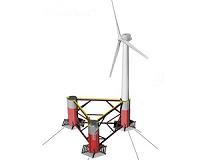 |
College Park MD (SPX) Jul 06, 2010 Wind turbines may be one of the best renewable energy solutions, but as turbines get larger they also get noisier, become more of an eyesore, and require increasingly larger expanses of land. One solution: ocean-based wind turbines. While offshore turbines already have been constructed, they've traditionally been situated in shallow waters, where the tower extends directly into the seabed. That restricts the turbines to near-shore waters with depths no greater than 50 meters - and precludes their use in deeper waters, where winds generally gust at higher speeds. An alternative is placing turbines on floating platforms, says naval architect Dominique Roddier of Berkeley, California-based Marine Innovation and Technology. He and his and colleagues have published a feasibility study of one platform design - dubbed "WindFloat" - in the latest issue of the Journal of Renewable and Sustainable Energy, which is published by the American Institute of Physics (AIP). By testing a 1:65 scale model in a wave tank, the researchers show that the three-legged floating platform, which is based on existing gas and oil offshore platform designs, is stable enough to support a 5-megawatt wind turbine, the largest turbine that currently exists. These mammoth turbines are 70 meters tall and have rotors the size of a football field. Just one, Roddier says, produces enough energy "to support a small town." The next step, says Roddier, is building a prototype to understand the life-cycle cost of such projects and to refine the economics models. The prototype, which is being built in collaboration with electricity operator Energias de Portugal, "should be in the water by the end of summer 2012," he says.
Share This Article With Planet Earth
Related Links American Institute of Physics Wind Energy News at Wind Daily
 Floating ocean wind turbines proposed
Floating ocean wind turbines proposedCollege Park, Md. (UPI) Jun 30, 2010 Wind turbines as a renewable energy source have problems of noise, visual clutter and land use, and one U.S. researcher says moving them offshore is a solution. Offshore wind farms have been built, but only in shallow water near coasts, and one naval architect wants to go much farther out by placing turbines on floating platforms, a release from the American Institute of Physics said We ... read more |
|
| The content herein, unless otherwise known to be public domain, are Copyright 1995-2010 - SpaceDaily. AFP and UPI Wire Stories are copyright Agence France-Presse and United Press International. ESA Portal Reports are copyright European Space Agency. All NASA sourced material is public domain. Additional copyrights may apply in whole or part to other bona fide parties. Advertising does not imply endorsement,agreement or approval of any opinions, statements or information provided by SpaceDaily on any Web page published or hosted by SpaceDaily. Privacy Statement |